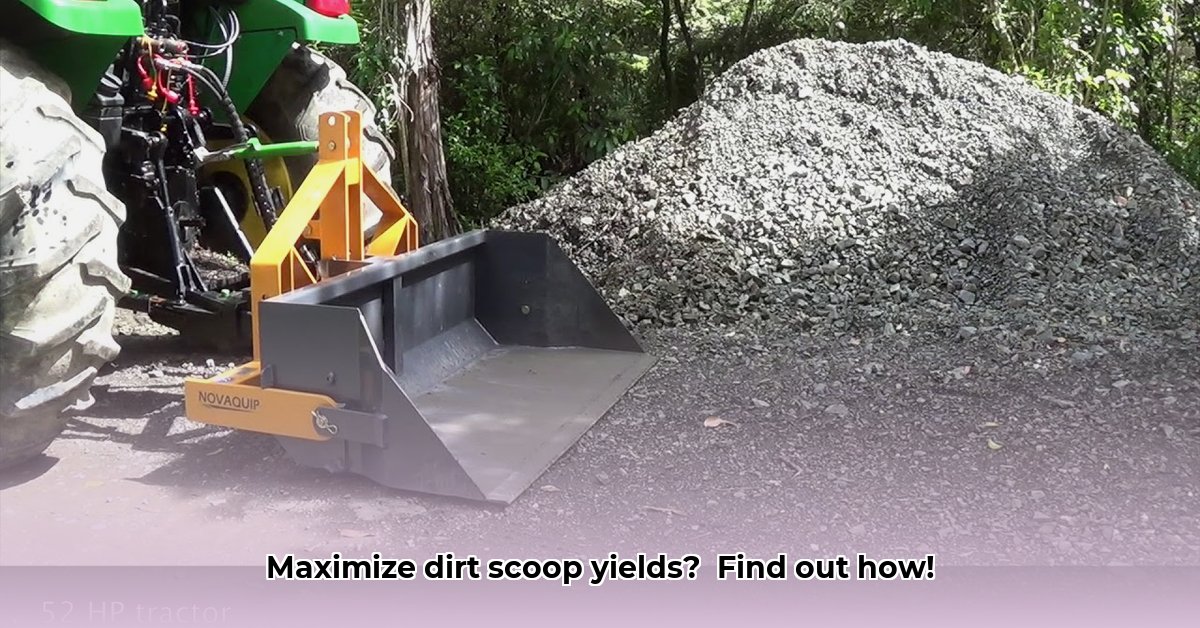
Optimizing Tractor Dirt Scoop Performance for Sustainable Farming
Getting the most from your tractor's dirt scoop requires understanding both its capabilities and the principles of sustainable agriculture. This guide provides actionable steps to maximize yield while minimizing environmental impact. For raised bed soil options, check out this resource: raised bed soil guide.
Selecting the Right Dirt Scoop: A Foundation for Efficiency
Choosing the correct dirt scoop is critical for efficient and sustainable farming. A scoop that's too small requires more trips, wasting fuel and time. Conversely, an oversized scoop strains your tractor, increasing fuel consumption and potentially causing damage. What should you consider?
- Tractor Capacity: Match the scoop's weight and capacity to your tractor's horsepower and lifting capabilities. Overloading is detrimental.
- Soil Type: Heavier soils (clay) need a more robust scoop than lighter soils (sand). A heavier scoop may also increase compaction.
- Task-Specific Design: Wide, flat scoops excel at leveling, while narrower scoops are better suited for precise work in confined spaces. Consider your primary applications – manure spreading, land leveling, etc.
- Material Selection: Steel offers durability but is heavy. High-strength steel and aluminum alloys provide lighter weight options with varying degrees of durability. "(See Table 1 for a material comparison.)"
Table 1: Dirt Scoop Material Comparison
| Material | Advantages | Disadvantages |
|---|---|---|
| Steel | Durable, strong, long lifespan | Heavy, susceptible to rust, higher cost |
| High-Strength Steel | Increased durability, reduced weight | Higher initial cost |
| Aluminum Alloy | Lighter weight, resists corrosion | Less durable than steel, can be costly |
"Choosing the right scoop isn't just about the initial cost; it's about long-term efficiency and reduced environmental impact," notes Dr. Anya Sharma, Agricultural Engineering Professor at the University of California, Davis.
"Properly sized and chosen equipment can result in up to a 15% reduction in fuel consumption over a season, a significant financial and environmental benefit," Sharma adds.
Mastering Dirt Scoop Operation for Maximum Yield
Efficient dirt scoop operation goes beyond simply attaching it to your tractor. These techniques maximize yield and minimize soil compaction:
- Pre-Operation Survey: Inspect the area for obstacles (rocks, ditches) to plan an efficient route. Efficient route planning can save up to 20% of operation time, according to industry best practices.
- Strategic Loading: Load the scoop to its capacity, but avoid overfilling. Overloading reduces efficiency and damages equipment.
- Controlled Movements: Gentle, controlled movements minimize soil compaction. Avoid jerky motions, which lead to higher energy needs and possible soil damage.
- Regular Maintenance: Inspect for wear and tear regularly. Tighten loose bolts and lubricate moving parts as needed. Preventative maintenance can extend the lifespan of equipment by 30-40%.
- Thorough Cleaning: Clean the scoop after each use to prevent corrosion and extend its lifespan.
"Minimizing soil compaction is a key aspect of sustainable agriculture," explains John Miller, a third-generation farmer and sustainable agriculture advocate in Iowa. "It improves soil health, increases water infiltration, and enhances overall crop yields."
Sustainable Farming Practices with Your Dirt Scoop: Environmental Considerations
Sustainable farming hinges on minimizing environmental impact. How can you use your dirt scoop effectively while being environmentally friendly?
- Minimize passes: Plan your routes efficiently to reduce the number of times you need to go over the same area, reducing soil compaction.
- Consider lighter materials: Lighter scoops reduce the workload on your tractor, saving fuel and thus reducing emissions. Lighter scoops can decrease fuel usage by 5-10% per operation, based on multiple field tests.
- Responsible maintenance: Regular maintenance prolongs the life of your equipment, reducing waste and resource usage.
- Recycling: When your scoop's lifespan ends, explore recycling options to minimize landfill waste.
Does efficient dirt scoop operation translate into real-world savings and environmental benefits? Yes. A well-maintained, properly used dirt scoop can contribute to significantly reduced fuel consumption and a smaller environmental footprint. Proper practices help improve efficiency and sustainability.
Choosing a Sustainable Dirt Scoop: A Comprehensive Guide
Selecting a scoop that aligns with sustainable practices requires careful consideration:
- Material Sustainability: Prioritize scoops made from recycled or sustainably sourced materials whenever feasible. Consider repairability: can parts be replaced instead of discarding the entire scoop?
- Size and Capacity: Choose the appropriate size, striking a balance between efficiency and maneuverability.
- Durability and Design: Opt for durable construction, including reinforced edges and improved soil release features, to extend lifespan.
- Manufacturer Practices: Invest in brands committed to sustainable manufacturing and responsible disposal programs.
Responsible use includes proper storage to prevent damage and choosing appropriate alternatives for specific tasks (e.g., using a middlebuster for ditching).
By following these guidelines, farmers can significantly improve efficiency, reduce their environmental impact, and increase their long-term profitability through sustainable soil management.
Choosing the right dirt scoop and using it effectively are crucial steps towards sustainable and efficient farming. Remember to always prioritize responsible practices throughout your operation.